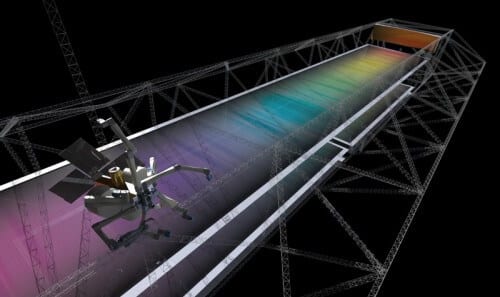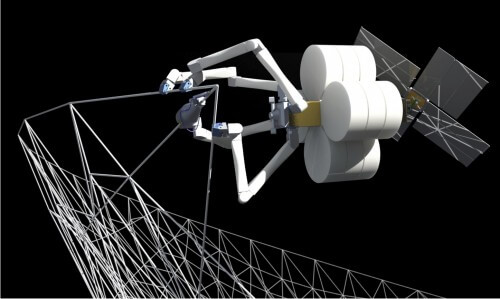TUI (Tethers Unlimited, Inc.) is developing a revolutionary set of technologies known as SpiderFab that will enable the production of large components for spacecraft and satellites in orbit. These are components such as antennas, solar collectors, accelerators and other structures that are currently manufactured separately from the spacecraft itself.

SpiderFab thereby upgrades the installation systems in space and enables the assembly of units on a scale of even kilometers within the current launch capacities and thus allows data to be transmitted at a higher resolution and at a lower cost.
The challenge that the system meets: as of today, a significant proportion of the engineering cost and mass of the launch into space is specifically required to allow the systems to survive the launch. This is especially true for physically large parts such as antennas, rods and panels, which must be designed to be stored at launch and then deployed reliably in space. Moreover, the size of the facilities and buildings in space is limited due to the requirement to store them in the available launch volume. Structures that are launched in parts and assembled in space or expandable components have made it possible to build systems on a scale of several tens of meters, but their packaging efficiency is not sufficient to allow them to grow within the limits of current launches to create kilometer-long baselines for needs such as long baseline interferometry and sparse distribution of sensors.
The technology: TUI is developing an architecture and technology kit for the automatic construction of large, multi-purpose structures in space such as kilometer-long antenna receivers. This process will make it possible to launch space systems in a compact embryonic state. Once the systems are ready, they will use techniques to manufacture and integrate components such as antennas, spacecraft casings, connecting rods and optical equipment.
The main advantage of manufacturing capability in space would be an order of magnitude improvement in the efficiency of storage and the mass of the systems, which would allow NASA to use small and cheap launchers to install significantly larger systems than are possible with the most advanced technologies today. The method will also allow NASA to acquire and distribute a variety of types of data from space with high resolution, greater bandwidth, improved signal-to-noise ratio and low cost of the life cycle.

Project status: The system receives assistance from NASA under the LaRC Phase I SBIR contract. TUI is developing the first stage of the SpiderFab architecture: a machine that will use XNUMXD printing technologies and robotic assembly systems to produce Trusselator large and powerful support units. that will allow the construction of buildings for large systems such as solar collector arrays with a power of hundreds of kilowatts, large solar sails and antennas in the area of a football field.
More of the topic in Hayadan:

7 תגובות
To the skeptics:
Launch/landing costs in space travel are the biggest costs.
Acceleration / braking costs vary depending on the type of engine (and mostly not large relative to the launch / landing costs.)
So a simple calculation means that it is much cheaper to use a space station than a permanent base on the moon. (even if compared to Earth the gravity there is 1/6)
exciting!
Sounds like a significant cornerstone for space stations
to the skeptics
There is no reason to look for aliens.
It's all a matter of distance and costs. A space station 400 km away
from the face of the earth. The minimum distance of the moon from the face of the sphere
363.104 km (907 times) This is the simple and only reason.
A large !
Miracles,
What nonsense are you talking about?
skeptical
Hellas nonsense
It is not clear to me why the establishment of a permanent base on the moon is being neglected?
Establishing such a base can save a lot of the expense of adding additional satellite clutter
and space stations, which is prone to many disasters.
Does this fact strengthen the rumors about the existence of alien bases there?